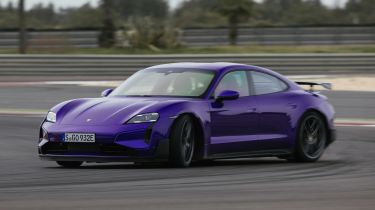What is traction control and how does it work?
Traction control is an almost universal feature of modern cars, and is particularly important for electric vehicles

Traction control has been mandatory on every new car sold in Europe since 2011 and became a common feature on road cars long before that date. This is a vital safety system that helps prevent loss of grip and in doing so averts innumerable car crashes every day. As long as the traction control system is working correctly, most drivers are hardly aware it's there, so it's easy to take for granted.
The main function of traction control is to prevent something called 'wheelspin'. We all remember the scenes in old movies in which somebody jumps into a car and speeds off amidst a symphony of squealing tyres and smoke, but traction control prevents this from happening in the first place.
Wheelspin happens when too much power is sent to a car's tyres, causing them to lose grip and spin faster than the car is moving. Instead of gripping the road, the tyres slide across it. This can also occur when a tyre touches a low-traction surface, such as gravel or ice, even momentarily.
When this happens, the driver risks losing control of the car. The rear of the car may swing out, known as ‘oversteer’, or the front may fail to turn properly, causing the car to go straight, which is called ‘understeer’.
When was traction control introduced?
Traction control systems first appeared in the 1970s on premium models like the BMW 7 Series and Mercedes S-Class. However, it wasn’t until the late 1980s and early 1990s when traction control started to become really effective and widespread. The cost of the technology had started to decrease, allowing everyday family cars to adopt their own traction control systems.
How does traction control work?
Traction control systems, while increasingly complex, operate on a straightforward principle. They rely on sensors to monitor the speed of each wheel and if the system detects that one wheel is spinning significantly faster than the others - an indication that the wheel has lost traction - it sends a signal to the engine control unit. This signal prompts the engine to reduce power to that wheel, allowing it to regain grip even if the driver is still pressing the accelerator.
To the driver, this intervention may feel like a brief hesitation in power delivery or a slight misfire, though it occurs almost instantaneously. Often, the only visible sign that traction control is active is a flashing orange or yellow warning light on the dashboard.
Modern traction control systems often include additional features such as Electronic Stability Control (ESC) or Electronic Stability Programme (ESP). These advanced systems do more than just manage engine power. They can apply braking force to individual wheels that have lost grip and even boost power to the wheels that still have traction. This sophisticated control helps keep the vehicle stable and improves overall handling in slippery conditions
How do I know the traction control is working in my car?
To see if your car's traction control system is functioning, look for a warning light on your dashboard. This light typically shows a car with two skid marks beneath it and will flash briefly when the system is active. If the light remains on after you start the engine, it indicates a problem with the system.

If the traction control warning light stays on, you should take your car to a dealership without delay so the problem can be diagnosed and rectified. A traction control warning light being permanently on will also cause your car to fail its MOT if it's due.
Should I ever turn the traction control off?
In most situations, it’s best to keep your traction control system on. This system responds faster than you can in conditions like snow, ice, gravel, or spilled fuel on a road, which helps to keep you safe.
However, if you’re driving on extremely icy or muddy ground, temporarily turning off the traction control can help. Some wheelspin can aid in getting the car moving, but be careful with the accelerator. Consult your car's owner's manual for how to do this, and make sure you reactivate the system when you're back on solid ground.
Does traction control work differently on electric cars?
Traction control in electric cars helps keep the wheels from slipping, much like in regular cars. Since electric cars deliver torque instantly, they can sometimes have trouble with grip on slippery surfaces. Traction control fixes this by reducing power to the wheels to prevent slipping and keep the car steady.
Electric cars also use a feature called regenerative braking, which turns movement into electricity. Traction control works with this braking system to make sure it remains smooth and effective, even on icy or wet roads.
Traction control also helps electric cars use energy more efficiently by stopping wheel spin, which can waste power and reduce how far the car can travel on a charge. Many modern electric cars have advanced traction control systems that can adjust power to each wheel for better handling.
